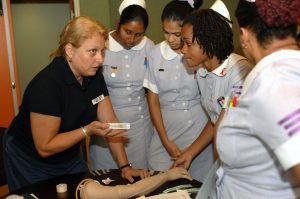 Recent outbreaks in cases of the Ebola Virus have left health care professionals concerned about their own well being during patient treatment, while also leaving them scrambling for ways to ensure that they address the worries of their patients appropriately.
Recent outbreaks in cases of the Ebola Virus have left health care professionals concerned about their own well being during patient treatment, while also leaving them scrambling for ways to ensure that they address the worries of their patients appropriately.
For a little background, in August 2014, the most recent outbreak of the virus occurred in the Democratic Republic of the Congo. This was the first outbreak of the virus since its discovery in 1979. There have been several occurrences throughout the years since, but only recently has there been cases in a number of countries.
Ultimately, it is important for nurses to be well informed about the facts about Ebola in order to further understand how to care for patients properly while keeping other patients secure.
The following are the top 6 things all nurses (and nursing students) should know about Ebola:
- Ebola is Not Transmitted through Air, Food, or Water.
Ebola was initially transmitted through wild animals. It is not certain which animal, but the World Health Organization (WHO) explains that researchers have narrowed it down to the fruit bat as the possible culprit. After a human has been infected, the only way to spread the virus is through bodily fluids, including blood, urine, saliva, etc.
- Know the Symptoms
Those working closely with patients who might have contracted the virus need to be fully aware of the symptoms. Typically symptoms will appear after 2 – 21 days of being infected. Ebola can be recognized by certain characteristics. Early symptoms are:
- Fever
- Fatigue
- Muscle pain
- Headache
- Sore throat
These are followed by more aggressive symptoms, such as:
- Vomiting
- Diarrhea
- Rash
- Impaired kidney and liver function
- Internal and external bleeding (oozing from the gums, blood in the stools).
- Infection Transmission
There is a misconception that people will carry the disease unknowingly for days, but the infection can only be transmitted from human to human if the individual is already having symptoms (no matter how mild they are).
- Outbreak in the U.S is Unlikely
It is natural for the general population to have a worst-case scenario state of mind when they first hear about a new disease, but it is important to communicate to patients that the likelihood of an outbreak in the US is farfetched. In recent developments, the WHO has stated that widespread outbreak is highly unlikely, due to facilities preparing appropriately, and because of the way outbreaks have been dealt with in the past.
- Currently, There is No Cure
Research shows that there is yet to be a treatment that can neutralize the virus. There are two vaccines currently undergoing evaluation that might be the key to counteracting the Ebola disease. Rehydration and symptomatic treatment improves the survival chances of one who is infected.
An interesting trait of Ebola is that once a patient has recovered, they are no longer susceptible to the virus — much like the chicken pox.
- Prevention is Key
The World Health Organization informs that following these new methods will help reduce the exposure of the virus. The following are basic ways that nurses can assist in controlling infection:
- Identify and isolate the Ebola patient in a single patient room with a closed door and a private bathroom.
- Limit the number of healthcare workers who come into contact with the Ebola patient (for example, avoid short shifts), and restrict non-essential personnel and visitors from the patient care area.
- Monitor the patient care area at all times, and log at a minimum entry and exit of all healthcare workers who enter the room of an Ebola patient.
- Ensure that a trained observer watches closely each donning and each doffing procedure, and provides supervisory assurance that donning and doffing protocols are followed.
- Ensure that healthcare workers have sufficient time to don and doff PPE correctly without disturbances.
- Ensure that practical precautions are taken during patient care, such as keeping hands away from the face, limiting touch of surfaces and body fluids, preventing needle stick and sharps injuries, and performing frequent disinfection of gloved hands using an alcohol-based hand rub (ABHR), particularly after handling body fluids. (World Health Organization)
Nurses and nursing students should feel more equipped to effectively prevent the spread of Ebola with these tips and facts. Although the contagious Ebola virus outbreak will eventually subside, the virus will still be among us. Not to mention, other contagious outbreaks of different viruses are likely to occur. Nurses and nursing students (especially those learning hands-on in the field) should always keep up to date with the latest information regarding a contagious disease. Always review the news, and check frequently with government sources, such as the Center for Disease Control, to ensure safety; take every precaution needed.
Get Started
If you are considering a career in the nursing field, Florida National University (FNU) is the way to go! Choose from a nursing certificate program, or study in one of our several accredited nursing programs to earn a nursing degree. We offer:
- Nursing Associate of Science
- Nursing BSN Entry Level
- Nursing BSN (RN to BSN)
The purpose of these programs is to prepare the students to become professional nurses, or registered nurses, able to function in a variety of roles.
FNU Knows What Nurses Need to Know
If you are interested in more information regarding the Florida National University Nursing programs, contact an advisor. Apply to the University today!
Works Cited
“Guidance on Personal Protective Equipment.” Centers for Disease Control and Prevention. Centers for Disease Control and Prevention, 21 Oct. 2014. Web. 11 Nov. 2014.



